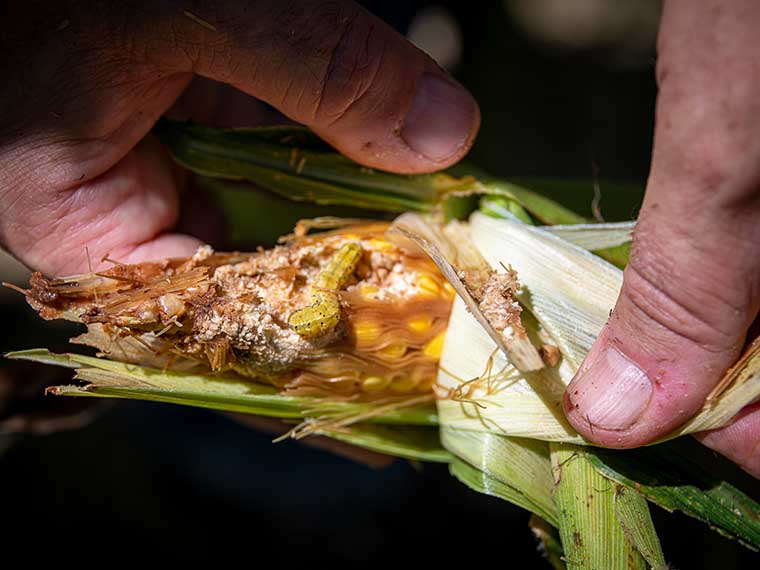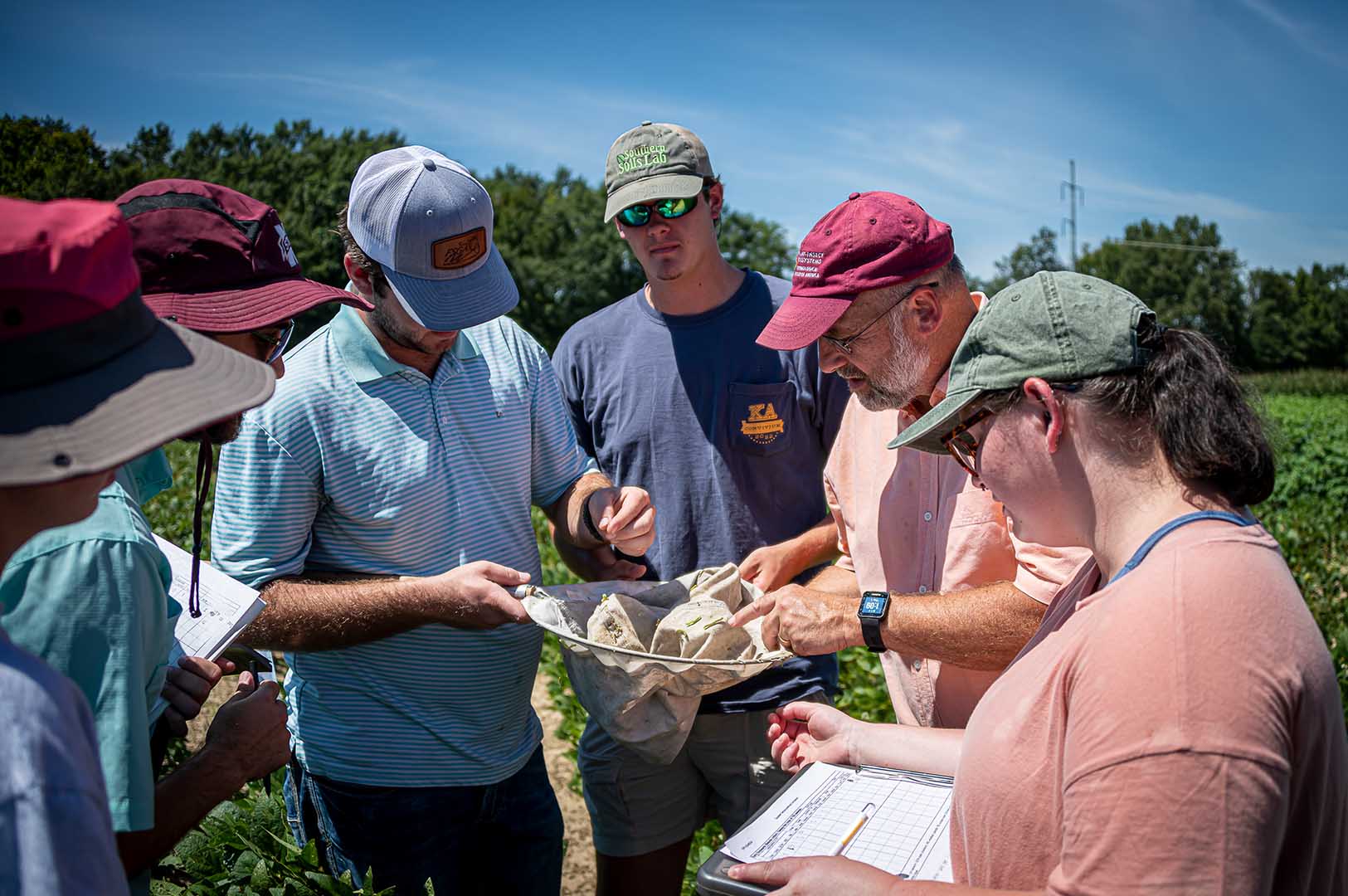The information presented on this page may be dated. It may refer to situations which have changed or people who are no longer affiliated with the university. It is archived as part of Mississippi State University's history.
Insect pressure in the field has long been a problem for row crop producers. Additionally, insects can damage stored grain, which can be a huge nuisance for farmers and grain elevator operators. Several types of insect pests can wreak havoc on row crops from cotton to corn to soybeans and more, impacting food quality and availability along with the producer's bottom line. In fact, the Food and Agriculture Organization of the United Nations estimates 20-40% of global crop production is lost to pests, including insects, noting invasive insects cost around $70 billion annually. MAFES scientists improve the efficacy of available insecticides while monitoring resistance to ensure defense remains available to combat these insect invaders.
In the Field
Dr. Fred Musser, a professor in the Department of Biochemistry, Molecular Biology, Entomology and Plant Pathology and MAFES scientist, studies corn earworms, soybean loopers, and tarnished plant bugs in row crops. He monitors insecticide efficacy and provides early warning when resistance occurs.
"I love what I do because I'm able to help row-crop producers while training the entomologists of tomorrow," Musser said.
One project focuses on tarnished plant bugs, the primary pest in cotton across the Midsouth, which typically affects cotton from squaring through bloom. Musser has monitored insecticide resistance in the pest for nearly 20 years. His research on the latest mode of action-an insect growth regulator called novaluron-has yielded beneficial and surprising results.
He said farmers often spray insecticides two to five times with reports of 10 applications in some situations. This costs time, money, and increases the potential for insecticide resistance.
"Tarnished plant bugs have multiple generations per year, so farmers must keep spraying. Also, the pests develop outside cotton fields, reproducing in other crops, so farmers must use significant efforts to keep them off the cotton," he said.
The plants are most susceptible to injury during the early bloom period, where the insects will eat small squares and bolls, leading to decreased yield and delayed crop maturity.
While researching novaluron impacts on insect populations in the field, the team serendipitously came across a way to increase the effectiveness of the product.
"Insect growth regulators like novaluron modify the growth of immature insects. This product kills insects once they molt. Generally, it doesn't impact adults. However, we found that the product seemed to give us the longest control when we sprayed it on adult populations, which was unexpected," Musser explained.
While the product was typically sprayed on nymphs, the team found that when they sprayed adults, control sometimes lasted longer. The team applied novaluron to adults in replicated lab trials, monitoring how long they lived, how many eggs they laid, and how many of those eggs hatched.
"Novaluron drops the hatch rate dramatically when applied to adult populations at just the right time. If the adults are very young and their eggs are not very far developed yet, it disrupts chitin synthesis, the material the insect's eggshell and exoskeleton are made of," he said.
Musser said the novel finding is helping farmers better manage tarnished plant bugs.
"Our results suggest that novaluron can target chitin or chitin-like components in the developing ovaries of adult tarnished plant bugs, which could lead to incorporating insect growth regulators in integrated pest management practices for controlling adult insect pest populations in the future," he said.
Musser and his team are also studying Helicoverpa zea, known as both corn earworm and cotton bollworm. He explained the pest has the largest economic impact in cotton and sweet corn, with little impact in field corn.
"In cotton, the worm can destroy all the bolls leading to crop failure. It also impacts sweet corn because consumers don't want to see a worm at the end of their corn ear. Field corn, however, has very few kernels at the tip and most of those are blown out of the combine so even if a corn earworm ate a handful of kernels at the ear's tip, we can't see any yield difference," he said.
The standard protection against Helicoverpa zea in corn is Bt-corn, which has been designed to ward off the pest. Musser and his team study the efficacy of Bt in protecting against corn earworm.
"From 2018 to now, we've been evaluating Bt-corn annually by comparing efficacy of infestation levels of corn earworm on varieties without Bt genes, with Cry Bt genes only, and with Cry + Vip3A Bt genes," Musser explained.
Musser reported that non-Bt and Cry Bt corn had greater than 95% infestation while the Cry + VIP corn ears were mostly clean. The larvae were able to complete development in the Cry-Bt ears, so at harvest, the amount of tip damage was similar in non-Bt and Cry-Bt.
Musser's Helicoverpa zea research also doubles as a teaching experience for his Field Crop Insects split-level entomology course where students visit the plots and record the number of insects in the corn, learning how to identify insects and the damage caused.
Musser also monitors soybean loopers for diamide resistance. Diamide insecticides became available in 2006 as a completely new mode of action to control moths, including agricultural pests such as the soybean looper. While the soybean looper in Mississippi has yet to demonstrate resistance to diamides, the same species is showing resistance in Puerto Rico.
Musser has been rearing soybean loopers from Puerto Rico and monitoring the insects in the lab. Most recently, he has joined forces with Dr. Seung-Joon Ahn, an assistant professor in the Department of Biochemistry, Molecular Biology, Entomology and Plant Pathology and MAFES researcher, who is now the principal investigator on a new project funded by the Mississippi Soybean Promotion Board.
"Diamides target the ryanodine receptor, an important calcium channel protein, in the insect muscle. About a decade ago, resistance to diamides was first reported in a couple of moth species, which was surprising because they were cases of relatively fast development of the resistance. Scientists were a bit embarrassed of such a fast resistance to the new insecticides, but they were also curious at the resistance mechanisms enabling the insects to adapt. Most cases were associated with mutations in one or two amino acids in the target receptor protein sequences," Ahn explained.
While Musser has expertise in monitoring diamide resistance in the soybean looper, the process involves rearing generations of insects before resistance or lack thereof can be confirmed. Ahn is seeking a more targeted method for monitoring resistance.
"If we know the molecular mechanisms of the resistance, we might be able to develop a diagnostic method that is more rapid and accurate than the conventional method. My goals are to characterize resistance mechanisms and develop a diagnostic tool using molecular biology techniques. The rapid and accurate diagnosis can benefit farmers and field applicators to decide which insecticide chemistry they should choose for their fields, because alternating insecticides would increase the control efficacy and reduce the chance of resistance," Ahn explained.
In the Bin
Once harvested, grain can be stored in silos for long periods of time. While steps are taken to protect the grain, it can still be susceptible to insects, which can cause major economic issues for growers across the globe. One of the factors that increases the risk of insect infestations in stored grain is the amount of time that growers hold the product. Marketing strategies and contract delivery dates contribute to growers harvesting and storing their grain for longer periods than in the past. While grain goes into the bins in late summer or early fall, grain that is removed during the winter or early spring has a lower risk of infestation compared to grain stored into the summer months or longer.
When insect infestation occurs, it can reduce grain quality. This can result in increases in grain temperature and moisture, which can lead to increases in fungal growth that can further deteriorate the grain. That's why Dr. Don Cook, MAFES researcher and associate research professor in the Department of Biochemistry, Molecular Biology, Entomology and Plant Pathology at the Delta Research and Extension Center, is monitoring insecticide efficacy in grain storage.
"Over the last 10 to 15 years, growers in Mississippi and the Mid-South have started to hold grain longer in grain bins on their farms for marketing purposes. Length of storage time and seasonal temperatures can increase the chances of insect infestations. Historically, most growers did not hold grain past April and had fewer issues. That's not necessarily the typical practice today. As grain has been held longer, the greater number of issues and the need for more management occurs," he said.
Cook said while insect issues in grain storage have been studied extensively in other parts of the country, little research on the topic has been conducted in Mississippi.
"After several growers had questions about how to manage these pests, we began testing the labeled insecticides in both corn and rice to see how they performed in our environment. The most important insect pests are rice and maize weevil in our area," Cook said.
The experiments are conducted in 30-gallon plastic drums designed to mimic grain bins. After the grain is treated, it is infested with insects from lab colonies, and is subject to natural infestations also. Insecticide efficacy is measured monthly.
"There are very few insecticides labeled for stored grain insect management. Generally, we test five different products and a control each year," Cook said.
He noted an unexpected issue that has emerged from the research is resistance, stemming from constant exposure.
"These insects can be fairly localized. We ran trials continuously at the same location for three years. Efficacy of all products declined during that period. The constant selection resulted in resistant populations. Similar things can happen in commercial settings if the same product is used continuously over time. However, with most farm bins, there is a period during the year where no grain is being stored and insects are not being selected, which slows the resistance selection process," Cook said.
Cook recommends several ways to help minimize insect infestations in grain from a grower's insect management perspective.
"Sanitize in and around bins. This includes removal of vegetation and debris from around the outside of bins, and removal of all old grain from in and around bins, including beneath the floor panels," he said. "As growers continue to store grain on their farms, particularly for longer periods of time, insect issues are likely to become more common."
MSU collaborators on the In the Field research include Dr. Natraj Krishnan, associate professor; Dr. Don Cook; Dr. Michael Caprio, professor; Dr. Jeff Gore, professor and head of the Delta Research and Extension Center; Beverly Catchot, former graduate student and current extension associate II; Chance JH Anderson, graduate student; and Sena Isbilir, graduate student, all in the Department of Biochemistry, Molecular Biology, Entomology and Plant Pathology. Collaborators outside of MSU include Dr. Clint Allen of U.S. Department of Agriculture's Agricultural Research Service (USDA-ARS), Dr. Dominic Reisig at North Carolina State University, Dr. Francis Reay-Jones and Dr. Jeremy Greene at Clemson University, Dr. Ryan Jackson at Syngenta, and Dr. Kuntol Rakshit at the Mayo Clinic School of Medicine. Funding partners include the USDA-ARS, Adama, Cotton Inc., and the Mississippi Soybean Promotion Board.
MSU collaborators for In the Bin include Meg Threet, research technician; Christina Mason, intermittent worker; Dr. Jeff Gore; Dr. Whitney Crow, assistant professor; and Dr. Angus Catchot, professor and associate director of MAFES. Outside collaborators include Dr. Tyler Towles at Louisiana State University and Dr. Nick Bateman, Dr. Benjamin Thrash, and Dr. Glenn Studebaker at the University of Arkansas. Funding partners include the Mississippi Corn Promotion Board and the Mississippi Rice Promotion Board.
I love what I do because I'm able to help row-crop producers while training the entomologists of tomorrow.
Dr. Fred Musser
Behind the Science

Fred Musser
Professor
Education: B.S., Agronomy, Penn State University; Ph.D., Entomology, Cornell University
Years At MSU: 18
Focus: Develop and monitor the efficacy of management strategies for insect pests of crops grown in Mississippi
Passion At Work: I want farmers and crop consultants to be able to use the best techniques available to manage insect pests in their crops and to be able to use them with wisdom and confidence.

Seung-Joon Ahn
Assistant Professor
Education: B.S., Agricultural Biology, M.S., Entomology, Seoul National University, Korea; Ph.D., Biological Sciences, Friedrich Schiller University, Germany
Years At MSU: 3
Focus: Genomics of insect-plant interactions and insecticide resistance
Passion At Work: I strive to understand how herbivorous insects intimately interact with biotic and abiotic environments using a variety of genomics tools, which hopefully will provide a novel strategy to manage pest insects and to protect beneficial

Don Cook
Associate Research Professor
Education: B.S., General Agriculture, Northeast Louisiana University; M.S., Agronomy, Ph.D., Entomology, Louisiana State University
Years At MSU: 15
Focus: Management strategies for insect pests of corn, soybeans, cotton, rice, and stored grain
Passion At Work: My goal is to help develop the most economical insect pest management strategies for growers in Mississippi.


